Foxgloves care and growing guide – expert tips for these cottage garden favorites
Our foxglove care advice has all the tips you need to bring height and color to your flower beds with these beautiful summer blooms


Leigh Clapp
Foxgloves are amongst our most elegant of easy-to-grow flowers. First, they develop a rosette of foliage at ground level and from it arise tall, upright spikes packed with two-lipped tubular flowers, opening steadily from the base upwards. The plants may be hardy biennials, hardy perennials or less frost resistant, slightly shrubby plants usually grown in containers.
In most varieties the flowers are carried on one side of the stem often creating a graceful arching look and the flowers may be large and prettily spotted in the throat or small, neat and tubular. Most foxgloves flower in spring and early summer, a few in summer or fall, and the flowers are usually purplish or pinkish in color, sometimes white, sometimes yellow plus a few in intriguing rusty shades. One has orange flowers.
Foxgloves are a stalwart of the cottage garden style, but will add color and height to any style of backyard and mixed flower bed. 'Statuesque plants for both formal borders and light woodland, the taller species make impressive specimen groups,' says the American Horticultural Society. Modern, recently developed varieties tend to be more compact, and well-branched, producing many more flower spikes to create a more colorful show. In some, the flowers are spread all around the stems so the plants look colorful from all directions and a few will flower the same year from seeds started in spring.
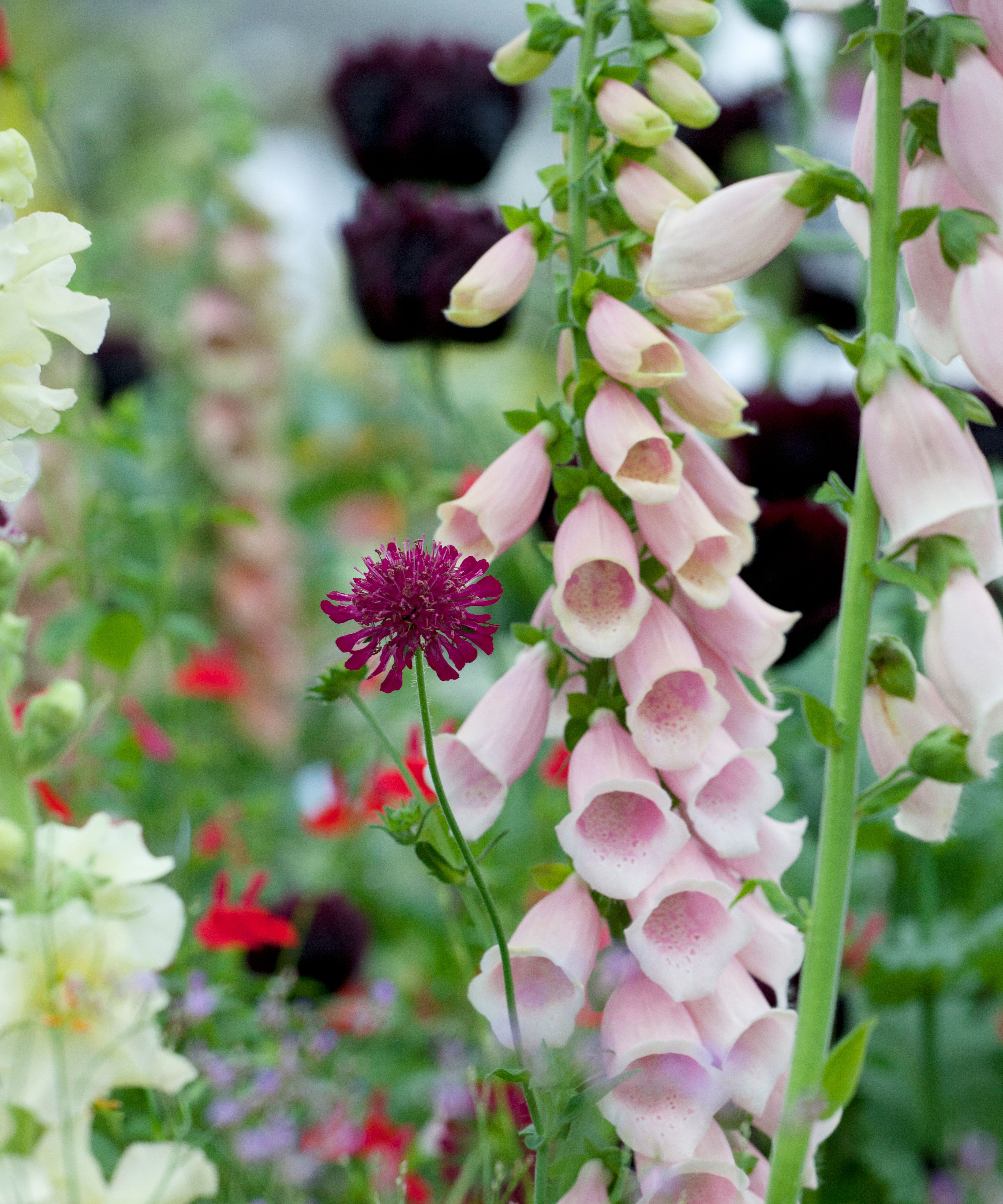
Foxgloves are perfect for cottage garden planting

Graham has a wealth of knowledge in all things horticulture. He trained at the prestigious Royal Botanic Gardens in Kew, England, and since then has written more than 20 books on plants and gardening and been a judge at Chelsea Flower Show, as well as writing for many gardening magazines and websites. He gardened in Pennsylvania for 20 years, but has recently returned to his native England.
Foxglove key facts:
- Plant type Hardy or half hardy biennial or perennial
- Mature size 2-6ft
- Soil type Any soil that is not parched or waterlogged
- Soil pH Acid, neutral, slightly alkaline
- Time to plant Spring, fall
- Flowering time Spring, summer
- Flower color All except scarlet and blue
- Hardiness zones USDA Z3-8
- Scientific name Digitalis
- Common name Foxglove
The different types of foxgloves
Foxgloves make a fabulous addition to flower beds, are excellent woodland plants, and are lovely as cutting garden flowers to enjoy in indoor displays, too.
There are three main types of foxgloves to choose from:
- Biennial foxgloves include the many varieties of Digitalis purpurea (USDA Z3-4) and are the most widely grown foxgloves. Seeds are sown in summer, rosettes of roughly textured foliage take the plants through the winter, then in spring the vertical stems surge into flower. The flowers are the largest of all foxgloves and are usually purple with dark spots in the throat although there are many other shades – with and without spots.
- Perennial foxgloves include some of our most cold-tolerant, though short-lived, perennial flowers, including yellow-flowered Digitalis grandiflora (USDA Z3). The rosettes are tightly packed with leaves and throw up self-supporting, stems with many small flowers mainly in yellow, coppery and reddish brown shades.
- The foxgloves best grown in containers, Digitalis x valinii, (sometime wrongly sold as Digiplexis), are derived from a much less winter-hardy (USDA Z8), orange-flowered type. These are the most prolific of foxgloves, flowering for months, never producing any seeds, and come in some rich and exotic colors.
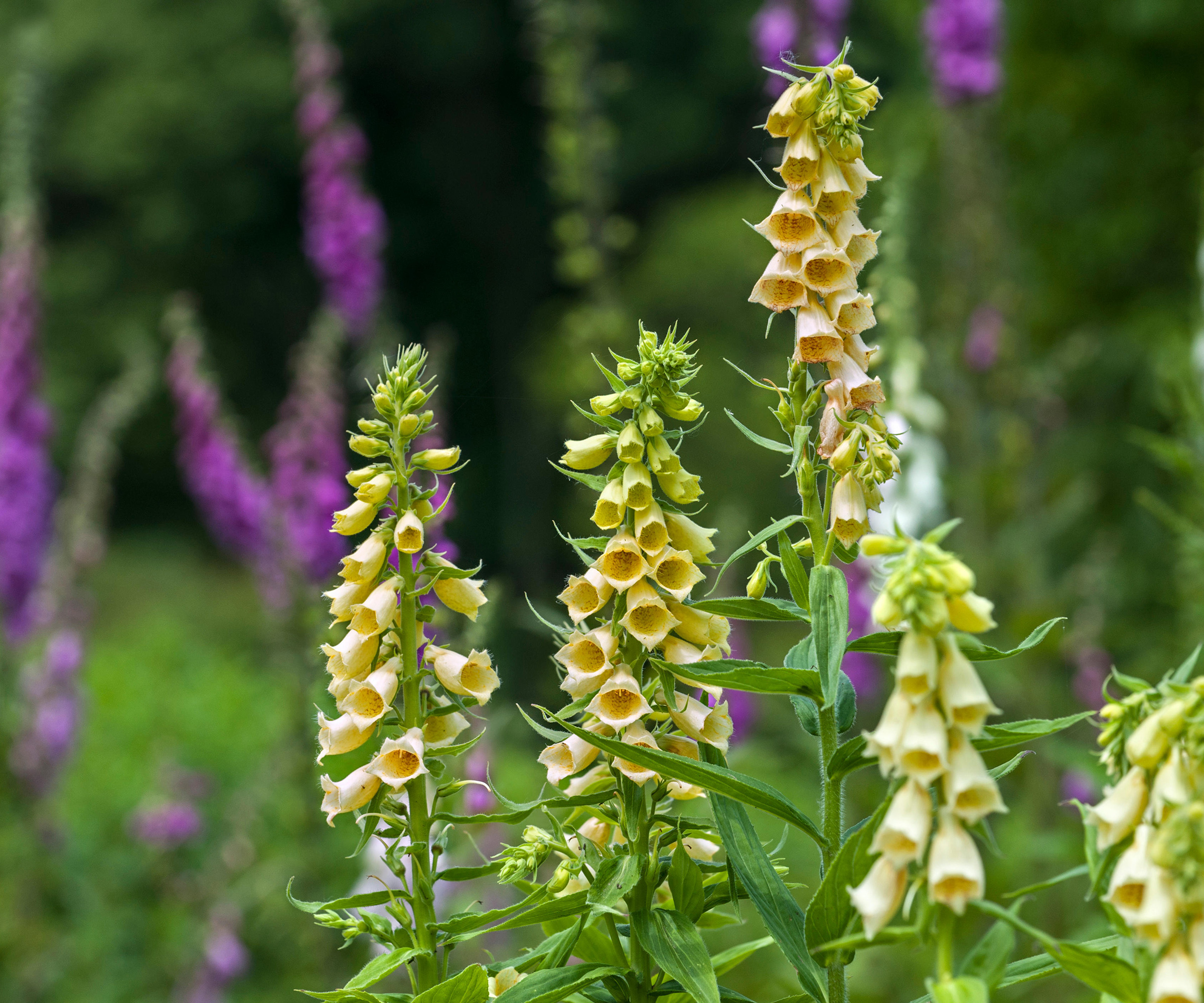
The pretty yellow creamy spikes of digitalis grandiflora
Choosing the right foxglove for your flower garden
Foxgloves are easy to grow, either from seed, seedlings or plug plants, and the common foxglove self seeds freely. The tubular blooms of the common foxglove also provide a valuable source of nectar, so consider gracing borders with drifts of these flowers as a way to boost your wildlife garden ideas.
'Digitalis plants are a classic of the cottage garden. Flowers range in colors from creamy yellow, pink, rose to maroon. The tall flower spikes with charming tubular flowers of foxglove add both height and vertical accent to your garden without staking. Perennial digitalis blooms attract hummingbirds and bees and an added bonus, the deer do not like the foliage,' say the experts at Bluestone Perennials.
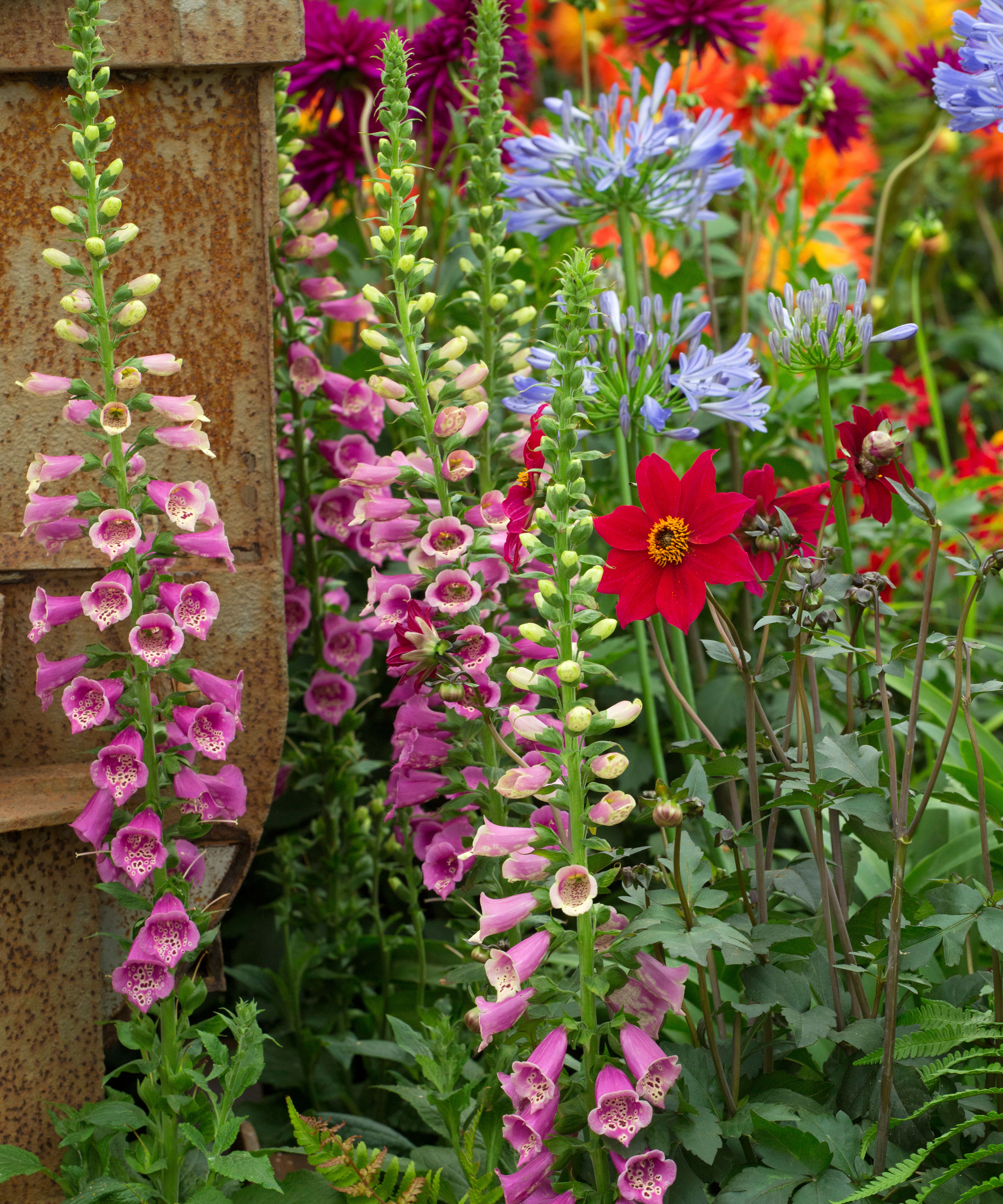
Foxgloves make an attractive addition to a mixed flower bed
For wild gardens in partial shade or mixed borders in sun, biennial foxgloves are ideal. Modern varieties including Dalmatian Series and Camelot Series are shorter, at 2-3ft, than older varieties and are better branched and more prolific.
For mixed borders, perennial borders and summer flower gardens in sun choose perennial foxgloves such as the yellow flowered Digitalis grandiflora or smaller flowered but longer lived Digitalis lutea.
For outdoor planters in sun or partial shade choose either modern biennial varieties or varieties of Digitalis x valinii. This is less winter hardy than other foxgloves but worth growing for the exotic coloring, exceptionally long season and powerful attractiveness to pollinators. Look for the Illumination Series, the Foxlight Series, ‘Falcon Fire’, ‘Berry Canary’ and ‘Firebird’. Move the containers into a cozy, sheltered place for the winter.
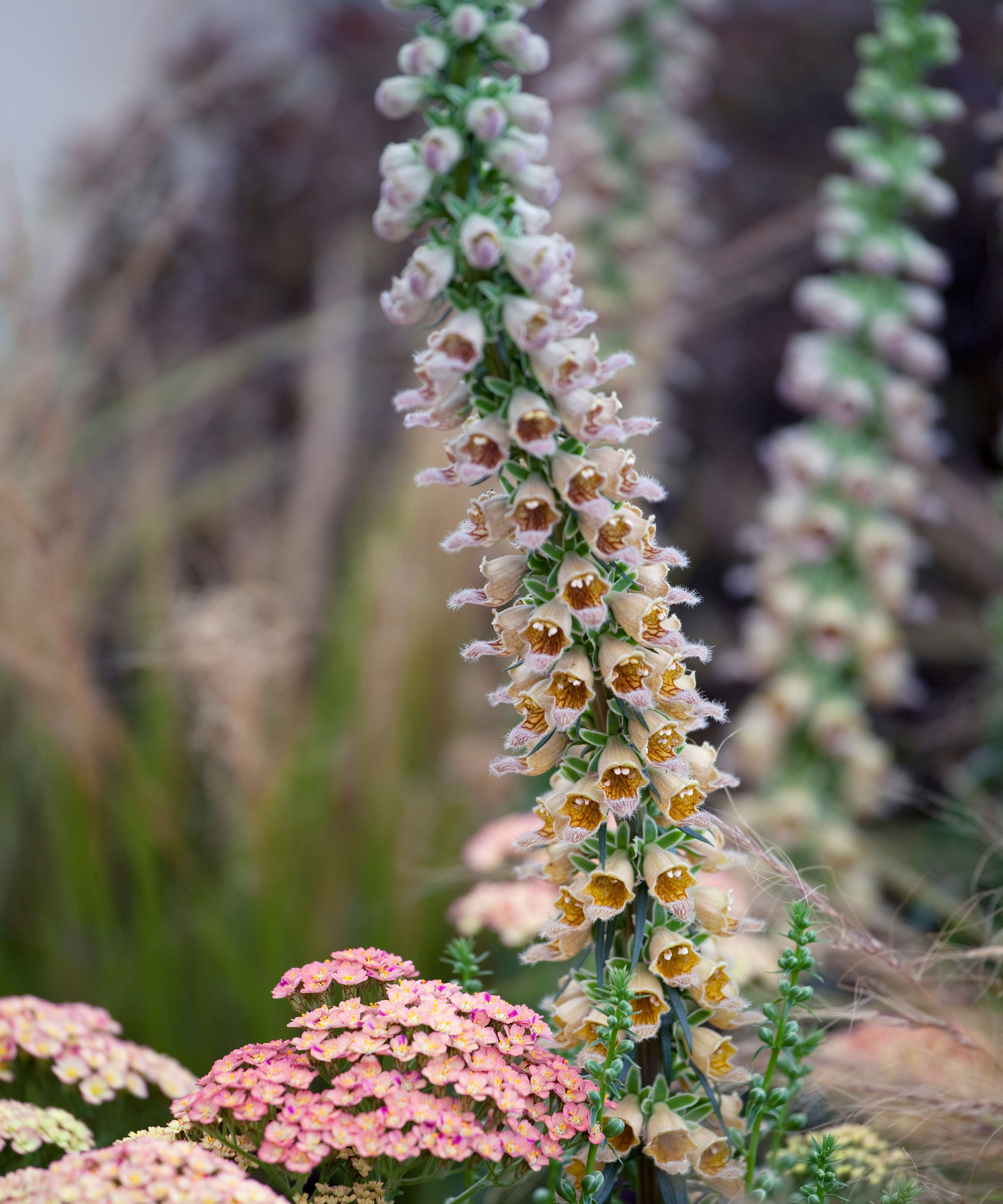
Digitalis ferruginea, also know as rusty foxglove
When and where to plant foxgloves
You need to plan ahead when growing foxgloves as the biennial varieties won't flower until the second year. To get common foxgloves to self-seed around the garden, plant them two years in a row.
In the summer of the first year, biennial varieties of foxgloves will put on leaf and root growth, they then remain dormant over winter, before bolting in early spring and flowering in early summer.
The great thing about foxgloves, as with many biennial flowers, such as honesty, campions and sweet rocket, is that they flower early in the summer, from late May and June through to July, filling the gap between the spring bulbs and the summer annuals.
Mail order suppliers will usually time their shipping to suit your hardiness zone; if not, ask for delivery in spring or early fall. The exception is Digitalis x valinii, the container foxglove, which should only be planted in spring.
Foxgloves need no special planting technique, just be sure that the soil is fertile and well-drained, amend with good garden compost if necessary and irrigate until established. Ensure that container compost is well-drained and raise the pots on pot feet to ensure good drainage of excess moisture.
Plants bought in flower may need to be staked to prevent wind damage to the flowering stems, using bamboo canes and garden twine usually works well.
Most foxgloves are happy in full sun or in partial shade, although old varieties such as ‘Excelsior’ may stretch and fall over without at least a few hours of sun each day. In general, they will all take more sun in cooler, northern zones and more shade in the south.
Water newly planted foxgloves for the first few months to help them spread their roots. Once established in their rich soil, they should only require watering in dry summer spells.
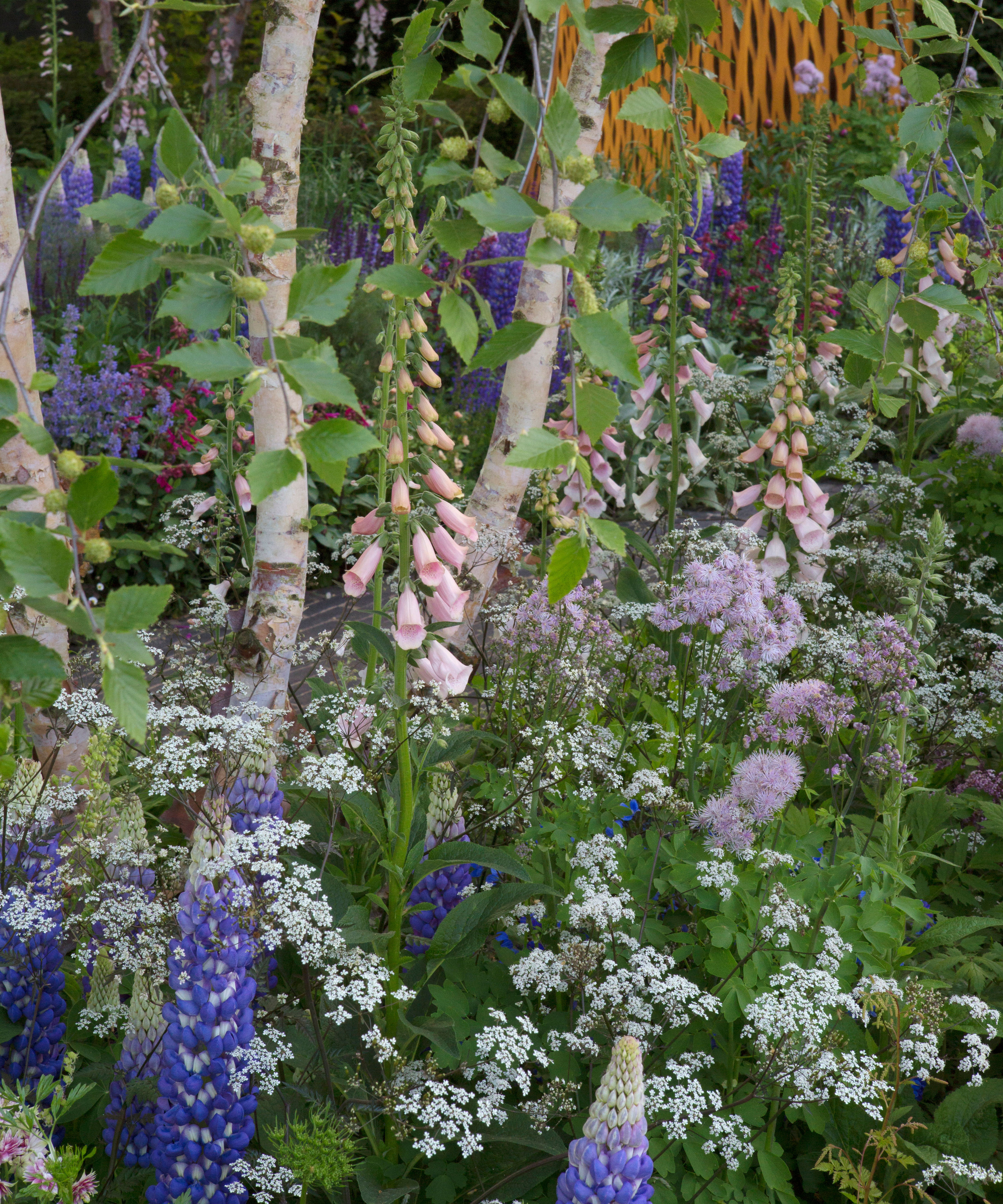
Add height to a colorful planting scheme with pretty foxgloves
How to grow foxgloves from seed
Foxgloves are easy to grow from seed, plus growing from seed is cheaper and there is often a greater variety to choose from.
You can scatter seeds directly in your garden, but as they are so tiny you may get better success sowing them indoors on good quality seed compost.
- If you are starting your foxglove seeds indoors, they can be grown in seed trays, either under cover in a greenhouse, in a propagator or under a transparent polythene bag on a sunny windowsill from later winter to mid spring. If sowing them indoors on trays, use a good quality, moist seed compost, but do not cover as they need light to germinate.
- Leave them in a sunny but sheltered position and keep well watered. Germination should occur within 14 to 21 days.
- When the seedlings begin to get crowded they can be ‘pricked out’ and individually planted into 3 inch pots to grow on.
- In early fall they can be planted out into the the position where they are to flower.
- Water for the first few months after planting.
If you are sowing directly outdoors into a flower bed, ensure the soil is raked to a fine tilth and sow in early summer – this gives them a good growing period throughout the summer and a chance to develop into healthy specimens. Thin the seedlings out to 12 inches apart.
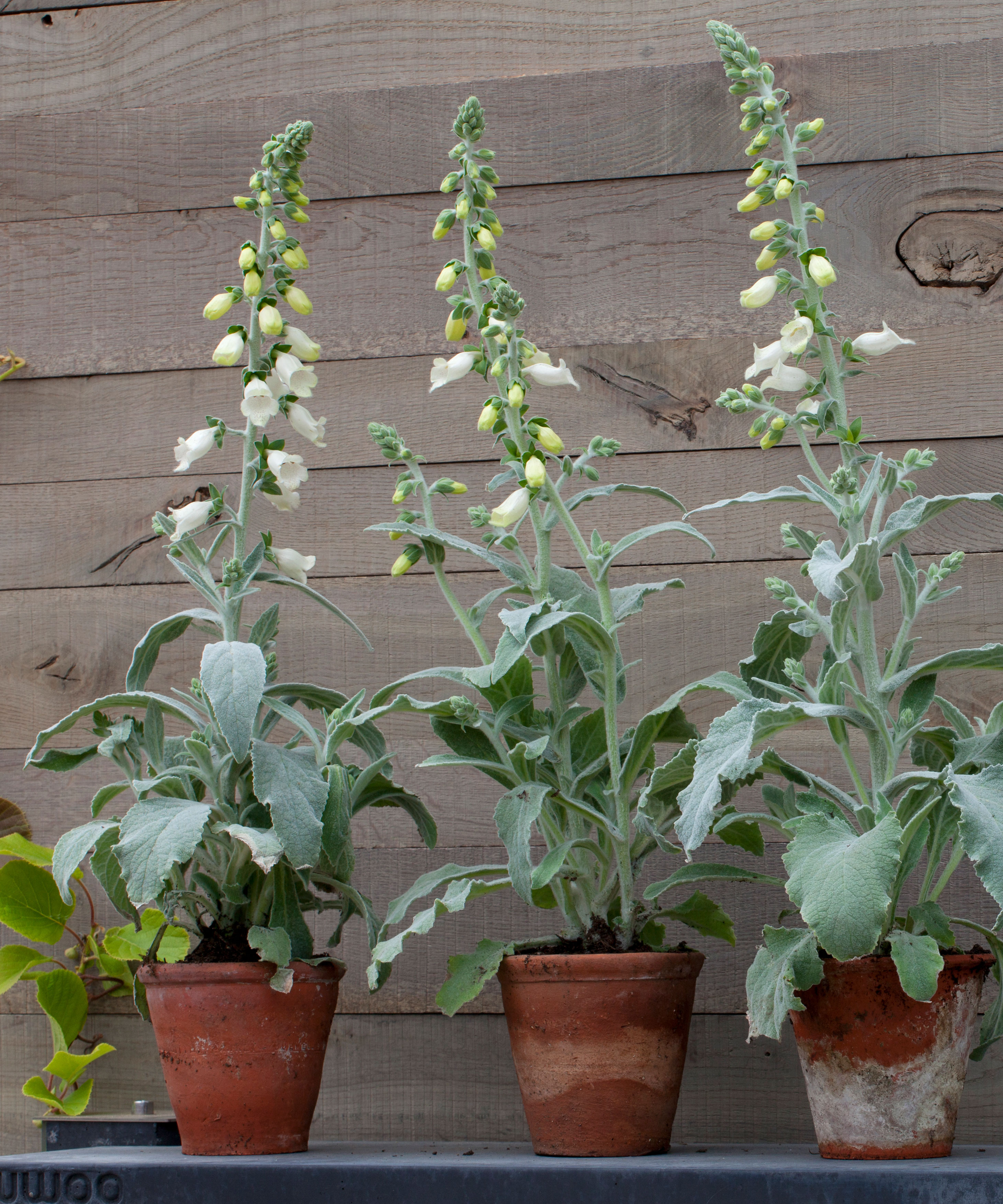
It's easy to raise new plants from seed
Growing foxgloves in containers
Most foxgloves can be grown in large pots as part of your container gardening ideas and there are also dwarf varieties available.
There are two main types of foxglove that make excellent container plants for the deck, some in full sun and some in partial shade.
In full sun, the tender container foxgloves, varieties of Digitalis x valinii (sometimes wrongly sold as Digiplexis), make super specimen plants. Reaching 2-4ft in height, branching well from the base and carrying unusually dark green leaves, the slightly flared flowers come in rich and exotic colors and color combinations, often involving rich plummy tones, deep pinks and honey or golden coloring. Feed well and ensure that drainage is good, especially in winter.
In shadier situations, or in full sun in cooler zones, the modern varieties of the biennial foxglove, including the Camelot Series and the Dalmatian Series (3-4ft), are significantly shorter than older varieties and branch more prolifically from the base to create a more colorful display for longer. These will die after their flowering display.
‘When growing foxgloves in containers, use a quality compost and feed the plant regularly, either with a slow release fertilizer or liquid feed. Do not let the plant get pot bound and do not overwater them. Cutting back the spent flower stems encourages even more flower stems to grow,’ says Mary Baker.
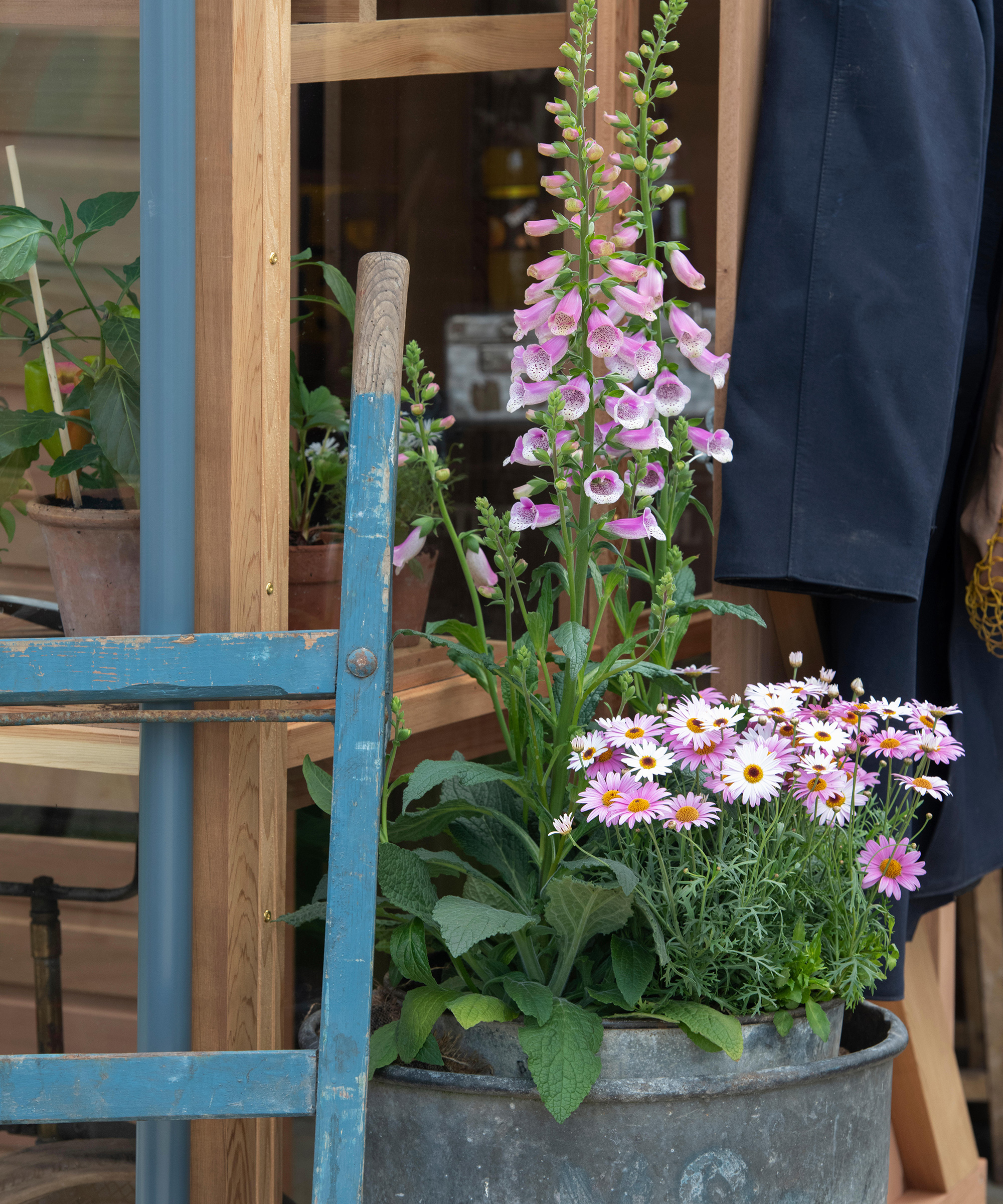
There are container foxgloves suitable for both sunny and shady spots
Foxglove care tips
All foxgloves benefit from deadheading. Not only does it prevent seed development and so encourage repeat flowering, but, in biennial foxgloves in particular, it prevents what can be an irritating number of self-sown seedlings appearing all over the garden.
Tall varieties may need some plant support, especially in exposed situations. Canes and twine do a good job, and can be removed at the end of the season. The canes can then be wiped down and dried off for use the following year. Foxgloves in containers can be supported using grow-thru wire plant supports.
Plants in containers need regular watering and fertilizing, they are hungry feeders and will flower so much more prolifically if kept well fed and watered. Stop feeding in the fall.
Cut back biennial foxgloves as flowering finishes, then dig up the remains of the plants and compost them. Cut back hardy perennial and container types to just above the rosettes of foliage after flowering.
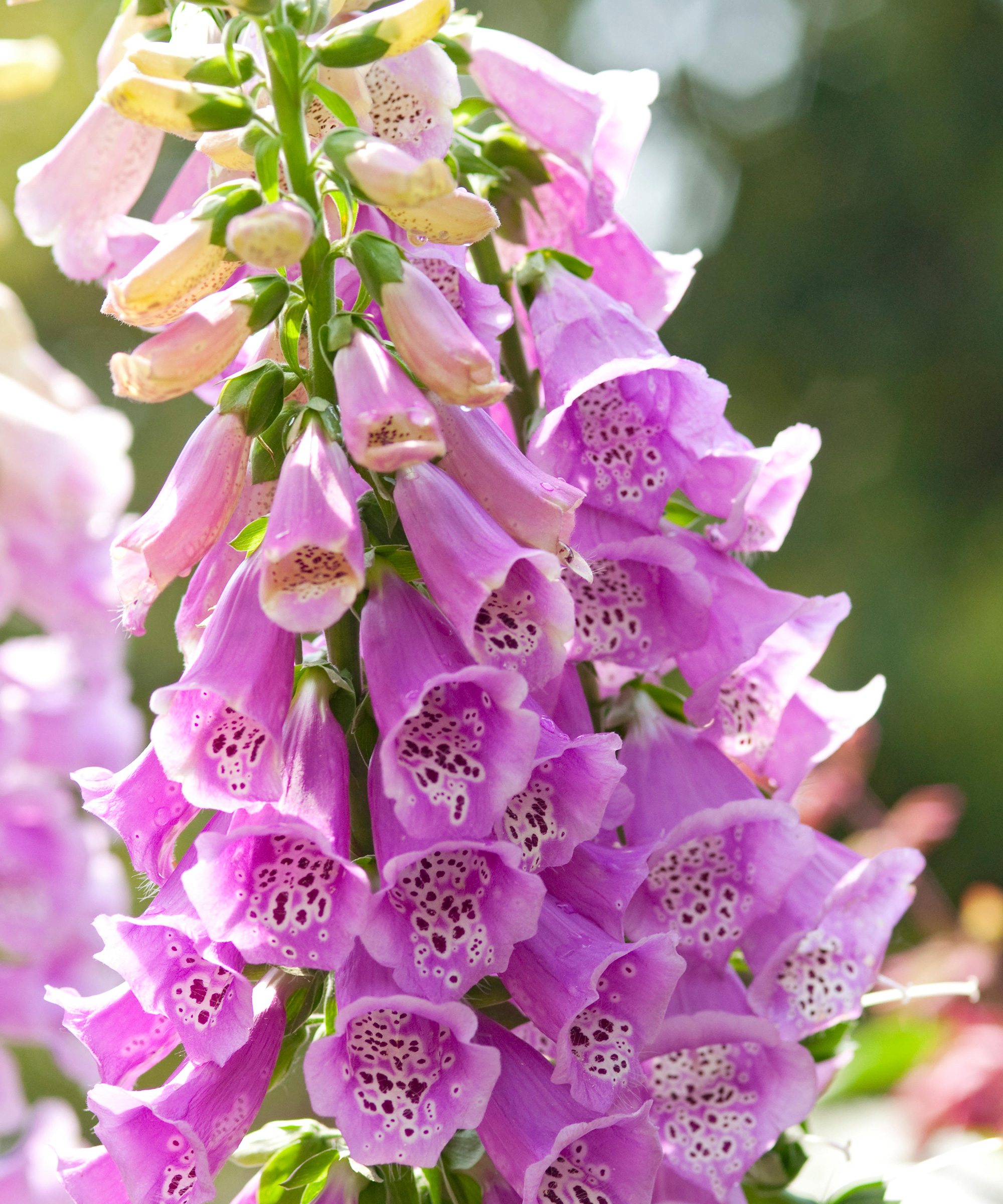
Large thimble-like blooms of D. purpurea, a true biennial foxglove
How to make more foxgloves for free
Biennial foxgloves will shed seed if not deadheaded promptly and new plants will quickly appear, sometimes in large numbers. They can be moved to suitable locations in late summer or early fall. You can also collect the seeds from plants. To do this, cut the stem with the seed capsules, place in a large paper bag and once dry the seed will fall out and will be ready to pack and store. The seeds can be sown in pots and the seedlings transplanted into individual pots for planting in later summer or fall.
Perennial foxgloves can also be raised from seed collected from your own plants and raised in the same way.
Plants of some perennial foxgloves can be carefully divided and replanted in spring. Shorter-lived types such as Digitalis ferruginea are unhappy after being divided but it works well for longer lived foxgloves such as Digitalis lutea.
Plants of Digitalis x valinii are sterile so produce no seed, and they also unsuitable for division so new plants must be bought every two or three years.

Collecting seeds from your plants is a great way to boost your foxglove collection
Foxglove problems and how to solve them
Foxgloves rarely suffer from pests or diseases but there are two main problems – in summary, too many or too few. One can be solved and the other cannot.
Biennial foxgloves in particular produce huge quantities of seed. It is said that one plant can produce two million seeds in one season – even if a tiny percentage of these seeds sprout and develop into plants your yard will be overwhelmed. The answer is deadheading. Look carefully at the seed pods at the base of the flower spikes and as soon as you see them turn brown and open – cut off the whole spike. This will stop seed being shed.
The other problem is that container foxgloves develop no seed at all – which is one of the reasons that flowering is so prolific. Also, they cannot be divided and there are no other ways to make more so you will never be able to propagate them yourself. Buying new plants for your containers or planter boxes is the only answer.
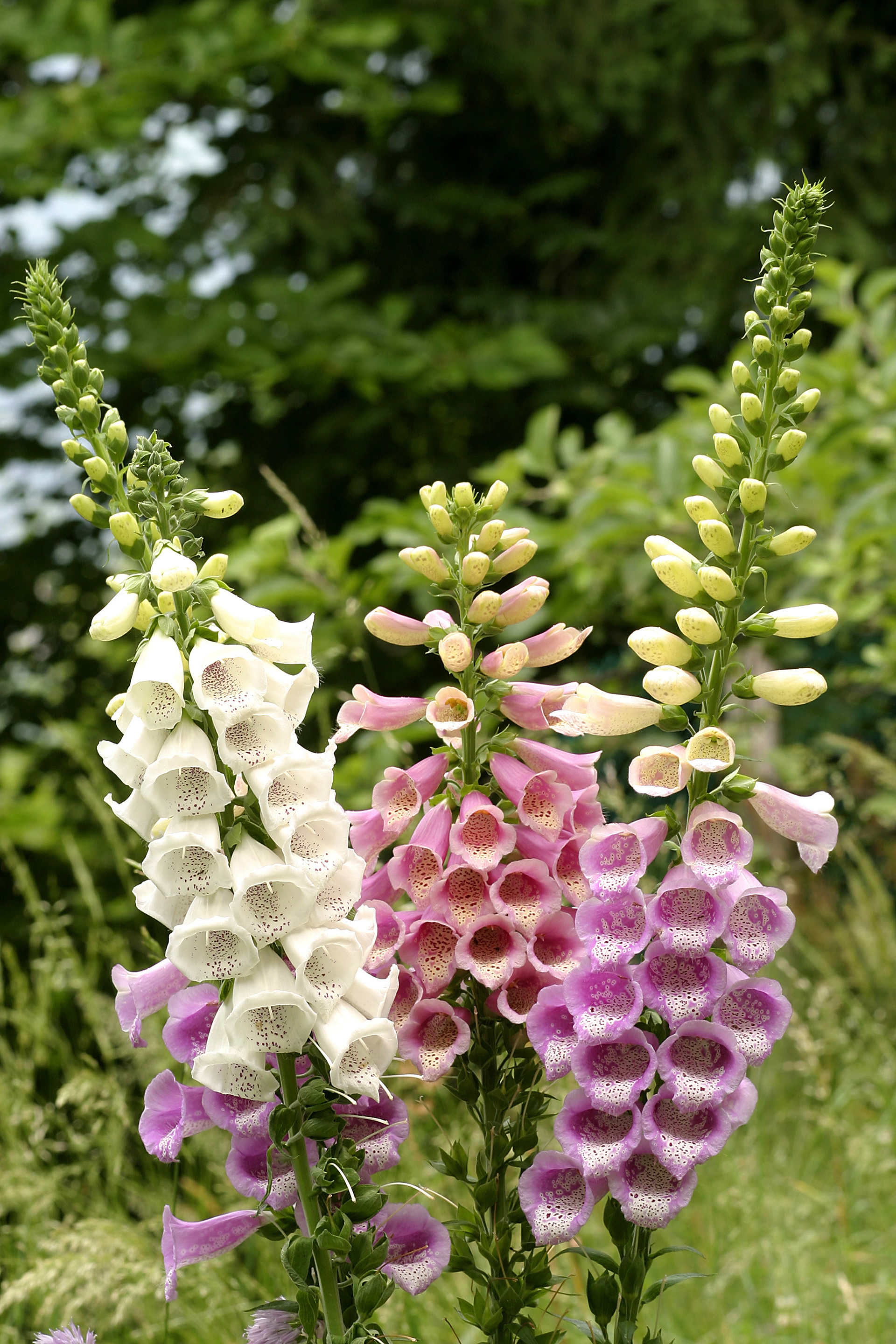
Regularly deadheading blooms will stop seeds from spreading
Do foxgloves come back every year?
There are some foxgloves that come back every year.
Some foxgloves are hardy biennials, such as foxgloves Digitalis purpurea and D. purpurea f. albiflora. This means they produce foliage and root growth in the first year, then flower and set seed in the second year before dying back. As they self-seed so freely, they can be thought of as short-lived perennials.
The species foxgloves are perennials, such as Digitalis Grandiflora, which flower a little later in summer, and will come back every year, lasting for three to five years.
‘Foxgloves are misunderstood as most gardeners think they are biennials. The species come true from seed, while the biennials cross-pollinate. Because of their ability to set seed easily, breeders can create wonderful hybrids that flower in their first year and continue to do so for a couple more years. Many set seed, but seldom recreate the parent they came from,’ explains Mary Baker.
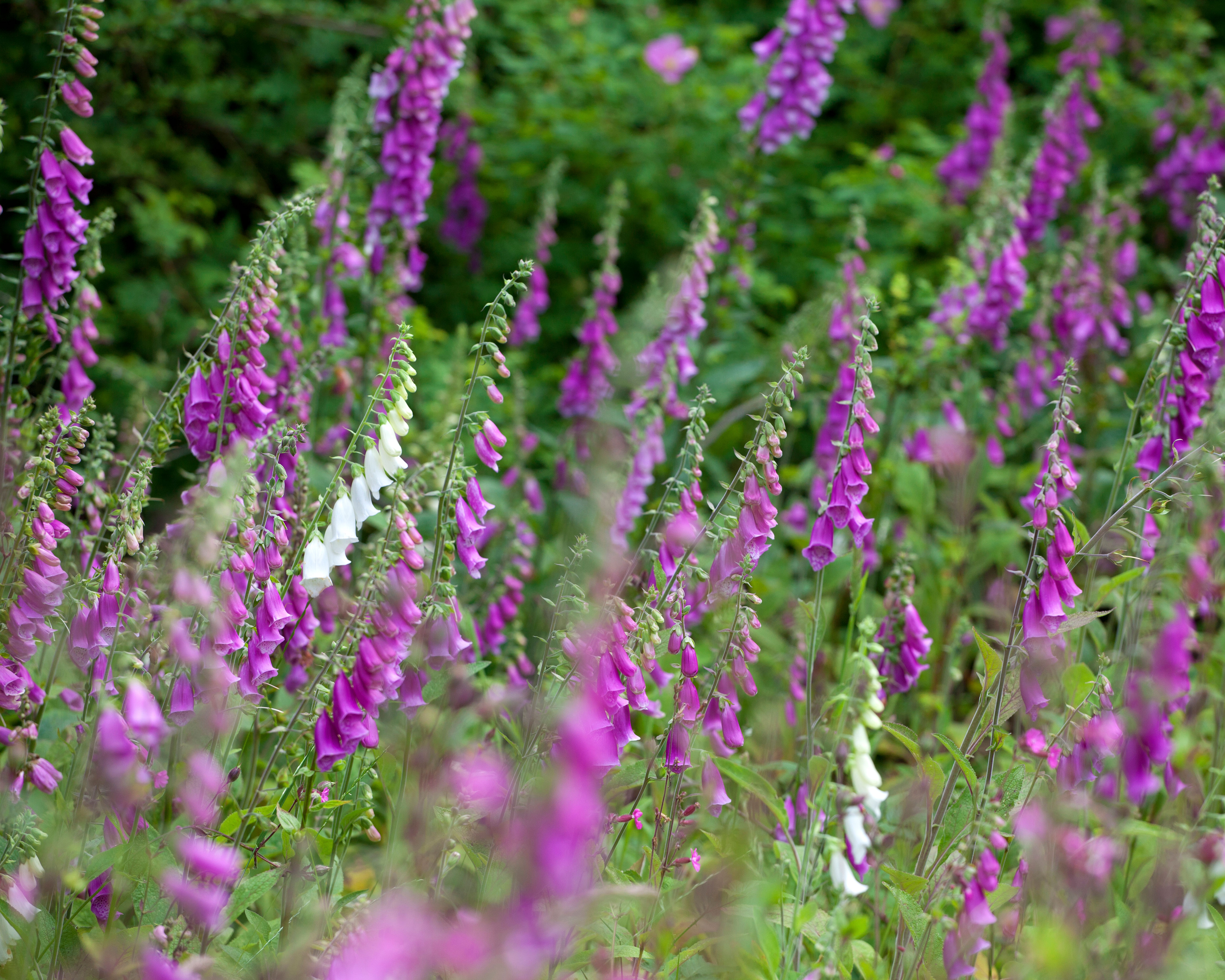
Do foxgloves spread easily?
Many foxgloves do spread as they readily set seed, meaning you can easily grow a bed full of them after a couple of years. In fact, they are so easy to grow this way that gardening guru Monty Don describes foxgloves as ‘a welcome weed’.
If you don’t want foxgloves to spread then the simple way to prevent this is to deadhead the flowers before they set seed. If you want more flowers, then simply leave them to do their thing. Alternatively, you can collect the seeds for sowing in trays.
If seedlings do pop up you can also easily transplant them to other areas of the garden. ‘We collect seedlings and move them to select spots around the garden, ideally with light shade, although, like all biennials, this must be done in the fall or late winter at the latest,’ reveals Monty Don in his book The Complete Gardener: A Practical, Imaginative Guide to Every Aspect of Gardening, available at Amazon.

Foxgloves can easily spread but there are ways to deal with this
Are there any foxgloves that will flower the same year that I start the seed?
Yes. Some modern foxglove varieties have been specifically developed to be grown as annuals – that is, seeds set in late winter will develop into plants that flower in the summer.
The varieties to look out for are the Camelot Series (in four colors and a mix), the Dalmatian Series (in five colors and a mix), and ‘Panther’ (rich pink).
Foxglove seed is very small, so some suppliers set each individual seed in a small pellet, making the seed much easier to handle. Sow it on the surface of your seed starting mix, water well but do not cover it.
Are foxgloves poisonous?
Foxgloves are poisonous plants for dogs and other animals as well as humans, but neither people nor pets have any reason to eat them.
The leaves, flowers, stems and seeds of foxgloves, and biennial Digitalis purpurea in particular, are all poisonous to humans and some animals owing to the presence of two chemicals that act on the heart. Symptoms include nausea, vomiting, a low pulse rate, confusion, blurred vision, loss of appetite, and problems that may lead to cardiac arrest. These same chemicals are also used by cardiologists in the treatment of some heart problems.
However, the plants are so unappealing as food, and so unpalatable, that no one would be tempted to eat foxglove leaves or flowers so they are considered safe to grow in gardens. Animals instinctively avoid eating any part of foxglove plants.
Are foxgloves deer resistant?
Yes. Biennial foxgloves are among the most deer-resistant plants that you can grow and are rated 'rarely damaged' by the experts at The New Jersey Agricultural Experiment Station. Hardy perennial foxgloves are a little less resistant and are rated 'Seldom Severely Damaged'.
If there is absolutely nothing else for deer to browse, they may occasionally eat biennial foxgloves but they are usually the last thing on the menu.
Are foxgloves invasive?
Biennial foxgloves, Digitalis purpurea, and safe to plant in much of the country but they have spread from gardens into wild habitats in the west, including British Columbia, and the north east. Foxgloves are noted as being invasive plants in parts of California but are not always considered to be a serious problem as their impact on native vegetation is not always thought to be significant.
How and where to buy foxgloves
There are three approaches to buying foxgloves.
Biennial foxgloves can be bought as seeds, as plug plants by mail order or as plants in pots retail or mail order.
Perennial foxgloves are usually bought in pots by mail order, or occasionally retail. Foxgloves for containers are bought in pots, usually by mail order although they are sometime seen in high end retail outlets.
The vast majority of foxgloves that we grow are biennial foxgloves grown from seed. But results from seed of your own garden plants can be unpredictable so it always pays to start with fresh seed from a seed company. Biennial foxgloves are also sometimes available, in flower, in walk-in nurseries.
Perennial foxgloves are much more dependable from seed, but also grow away well when bought as plants. Mail order plants will arrive in spring, or sometimes fall, for immediate planting.
Plants of container foxgloves will be shipped in spring for planting in large containers after the final frost in your area.
Sign up to the Homes & Gardens newsletter
Design expertise in your inbox – from inspiring decorating ideas and beautiful celebrity homes to practical gardening advice and shopping round-ups.

Graham Rice is a garden writer who has won awards for his work online, and in books and magazines, on both sides of the Atlantic. He is a member of a number of Royal Horticultural Society committees and the recipient of the 2021 Garden Media Guild Lifetime Achievement Award. He gardened in Pennsylvania for 20 years, but has recently returned to his native England.
- Leigh ClappContributing Editor
-
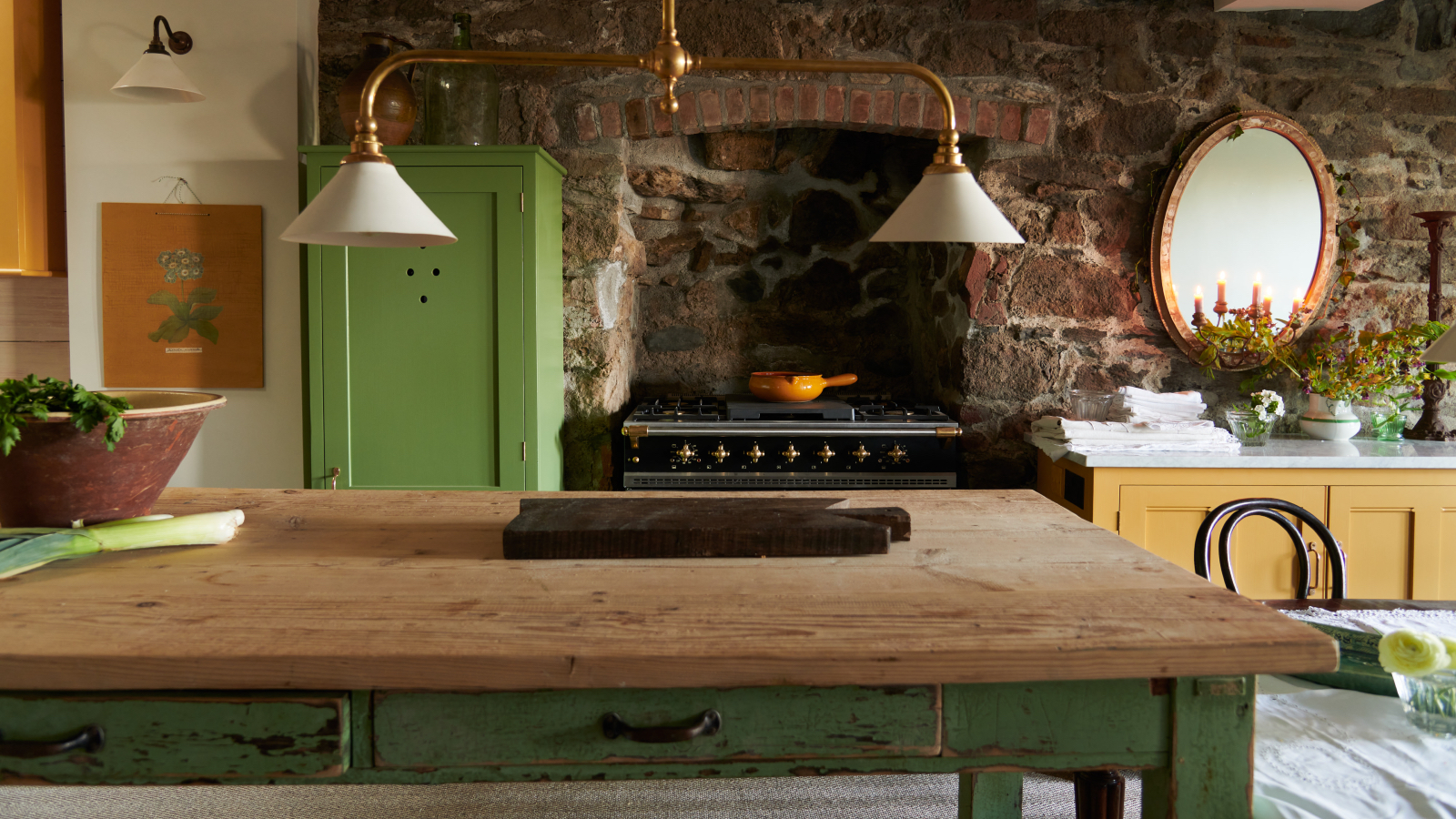 9 things you can clean with glycerin – this cheap and natural cleaner is perfect for indoor and outdoor use
9 things you can clean with glycerin – this cheap and natural cleaner is perfect for indoor and outdoor useFrom patio furniture to silverware, this hydrating and gentle cleaning agent will work miracles
By Ciéra Cree Published
-
 Martha Stewart's houses – inside her most iconic properties, from Cantitoe Corners to Turkey Hill
Martha Stewart's houses – inside her most iconic properties, from Cantitoe Corners to Turkey HillThe lifestyle guru built her legacy around her homes, some of which are the most recognized homes in modern American history – we explore her portfolio
By Megan Slack Published
-
 Water garden ideas – 9 ways to introduce soothing water to your outdoor space
Water garden ideas – 9 ways to introduce soothing water to your outdoor spaceFrom cascading fountains to wildlife ponds, there are plenty of ways to create a tranquil water garden
By Leigh Clapp Published
-
 How to grow poppies
How to grow poppiesFind out how to grow poppies to enjoy the beauty of these brightly colored tissue paper-like blooms
By Leigh Clapp Published
-
 How to grow delphiniums from seed
How to grow delphiniums from seedFind out how to grow delphiniums from seed and enjoy these colorful cottage garden favorites filling beds and borders
By Leigh Clapp Published
-
 How to grow ferns – when and how to plant and care for them
How to grow ferns – when and how to plant and care for themLearn how to grow ferns to enjoy the texture and form of these versatile plants in many areas of your garden
By Leigh Clapp Published
-
 How to grow sweet peas from seed – in borders and pots
How to grow sweet peas from seed – in borders and potsFind out how to grow sweet peas and where to enjoy their wonderful color, ruffled blooms and sweet fragrance in your garden
By Pippa Blenkinsop Published
-
 How to make fat balls for birds – easy steps feed our feathered friends
How to make fat balls for birds – easy steps feed our feathered friendsLearn how to make fat balls for birds to ensure their wellbeing throughout the winter
By Holly Reaney Published
-
 Planning a kitchen garden – from layouts to picking the best crops
Planning a kitchen garden – from layouts to picking the best cropsPlanning a kitchen garden is easy with this expert advice – whether yours is in beds, borders or a dedicated patch – you're guaranteed success
By Leigh Clapp Published
-
 How to grow cosmos – expert tips on when and where to plant these flowers
How to grow cosmos – expert tips on when and where to plant these flowersLearn how to grow cosmos to add bright color in your garden from summer through to fall with their beautiful blooms
By Leigh Clapp Published